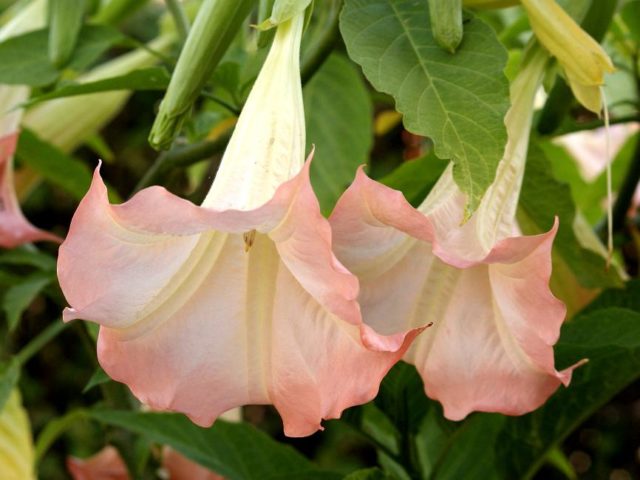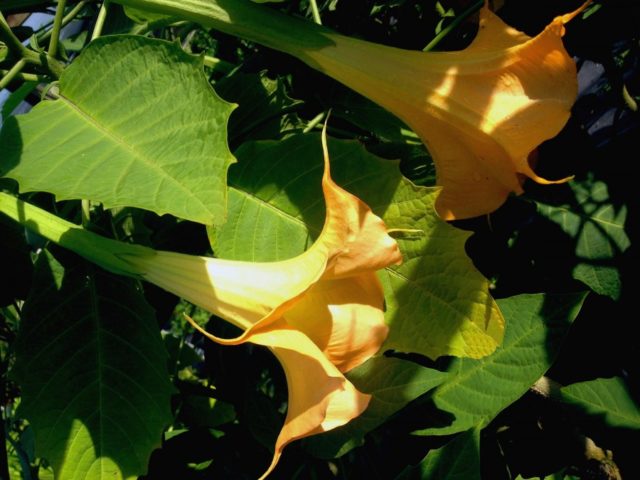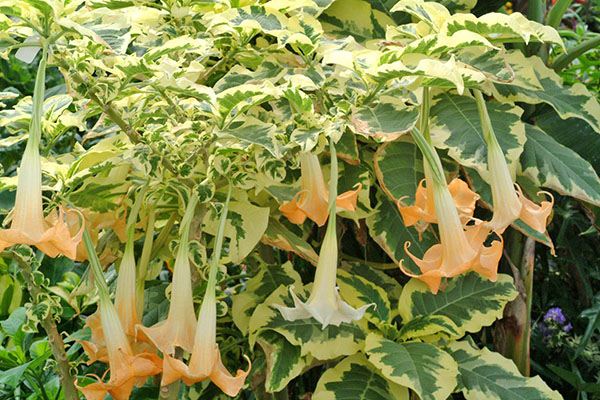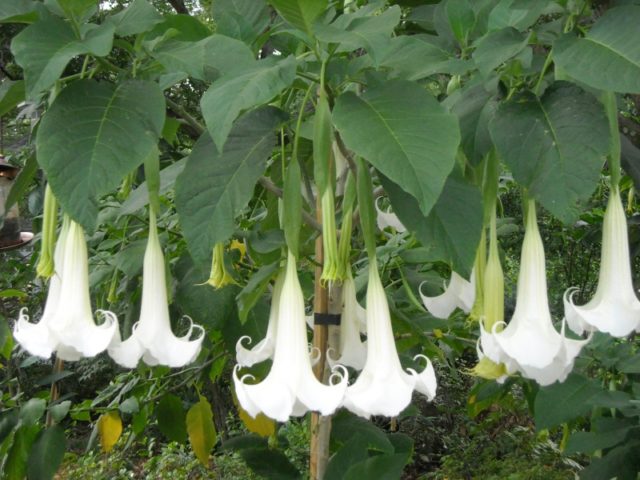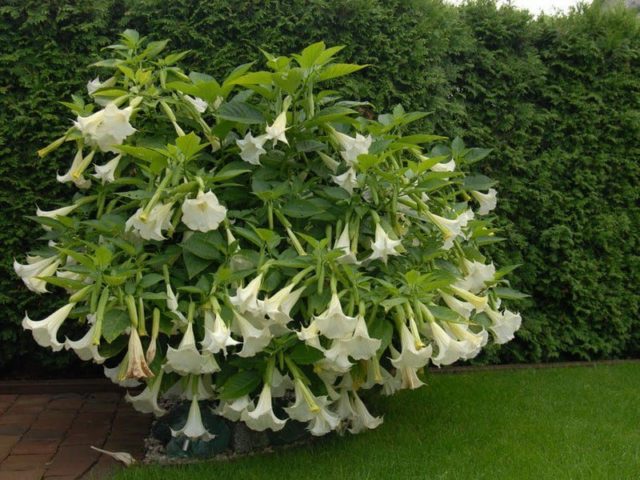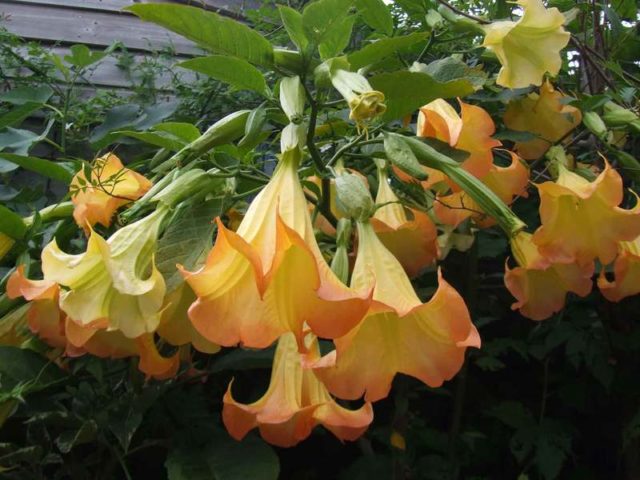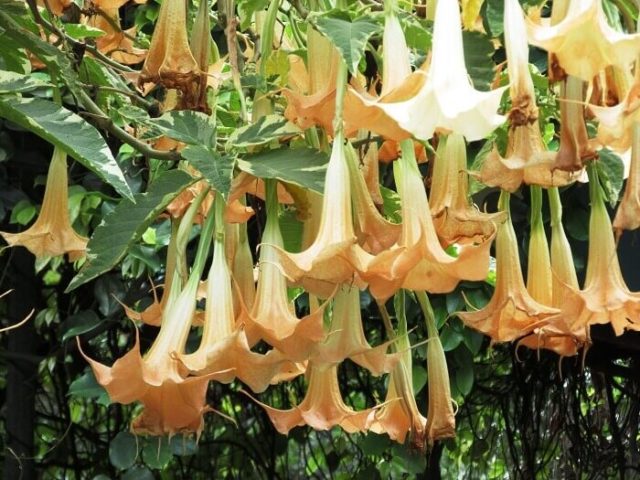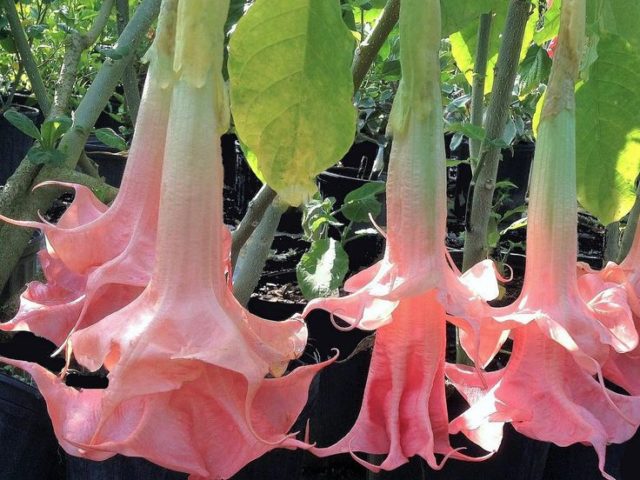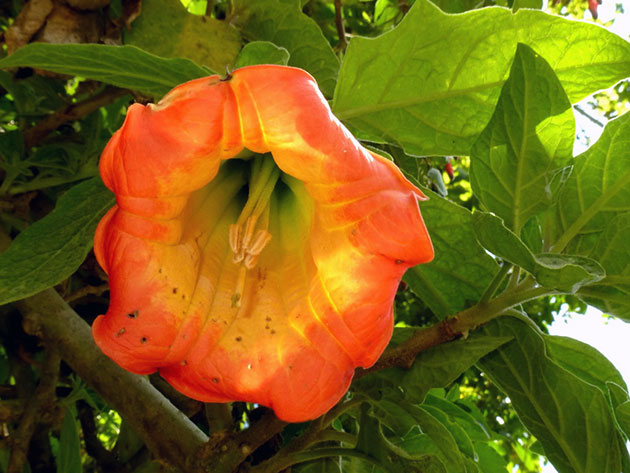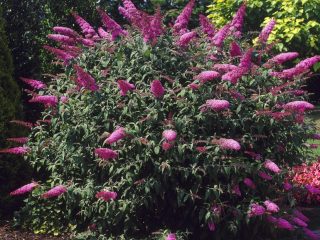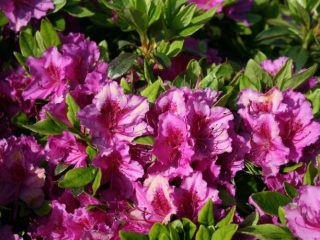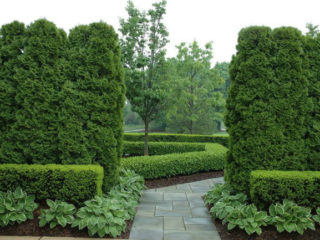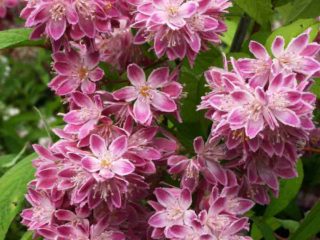Content
- 1 Description of brugmansia
- 2 Varieties and types of brugmansia
- 3 Brugmansia in landscape design
- 4 Growing brugmansia from seeds
- 5 How to plant brugmansia in open ground
- 6 How to care for brugmansia outdoors
- 7 How to keep brugmansia in winter
- 8 Features of growing and caring for brugmansia at home
- 9 Blooming brugmansia
- 10 How to propagate brugmansia
- 11 Diseases and pests of brugmansia
- 12 Conclusion
- 13 Reviews about brugmansia
Planting and caring for brugmansia in the open field is an interesting question for gardeners who are fond of cultivating delicate but very beautiful southern flowers. If desired, brugmansia can be grown in almost any climate, but for this you need to know everything about its requirements and features.
Description of brugmansia
Brugmansia, or "angelic trumpets", is a tropical flower from the Solanaceae family. In their natural form, these small shrubs and trees up to 2-3 m in height grow in the forests of South America, but are cultivated all over the world.
The main and most noticeable feature of brugmansia is its flowers - large drooping bells up to 25 cm in length and with a wide, up to 20 cm, bell. Depending on the variety, the flowers can be white, pink or yellow and are characterized by a strong intoxicating aroma. Brugmansia blooms several times per season and is very luxuriant - up to 300 individual flowers can form on a well-developed bush in 1 run.
Varieties and types of brugmansia
The tropical flower is cultivated in many varieties. Among themselves, the varieties differ mainly in size and shade of flowers, while the rules for planting, growing and caring for the brugmansia plant remain the same.
Fragrant brugmansia
The Brazilian variety reaches 5 m in height and is distinguished by white large flowers up to 30 cm, sometimes the flowers of the plant can have a light green tint. The bell of the calyx can be up to 15 cm in diameter. As the name implies, fragrant brugmansia has a particularly strong pleasant aroma - with proper planting and care, the flower can transform any garden.
Bloody brugmansia
Blood-red, or bloody brugmansia is a tall flowering tree up to 12 m tall. The plant got its name because of the shade of flowers; they are orange with yellow veins and a red edging in this variety of Brugmansia. The variety is characterized by increased frost resistance, but it still remains very sensitive to cold weather.
Brugmansia golden
An ornamental variety with many varieties, it is distinguished by its high growth up to 6 m and beautiful yellow flowers with wide sockets. A characteristic feature of golden brugmansia is its very large soft leaves, which can reach up to 50 cm in length.
Variegated brugmansia
This variety can be considered the most unusual - multi-colored brugmansia reaches up to 4 m in length and brings huge flowers up to 50 cm each.At the same time, in young plants, the flowers are white or soft cream, and in an adult variegated brugmansia, they become peach or even orange. Another feature is the unusual color of the flower leaves, decorated with a delicate cream edging.
Snow-white brugmansia
As the name implies, this variety and many of its hybrids bloom with snow-white, yellowish or apricot flowers. The average length of flowers is about 25 cm, a shrub with good care can grow up to 3 m in height.
Brugmansia in landscape design
Gardeners love the tropical plant for its decorative characteristics. Brugmansia of white, yellow and pink varieties are planted on the site in both single and group plantings. Low flowers can decorate flower beds and flower lawns, discounts and flower beds. Medium-sized shrubs can be planted next to hedges - brugmansia looks luxurious against the background of deep greenery and effectively sets it off with itself.
Also tub plants are often used to decorate terraces, gazebos and spaces near gates and gates. However, when organizing a landscape, it is necessary to remember about the toxicity of a tropical flower and plant it where animals and children cannot be poisoned by leaves and flowers, and the smell of flowers will not be too intrusive.
Growing brugmansia from seeds
Planting a flower on a site from scratch is most often carried out using seeds.
- It is necessary to sow the material into containers from January to March. The soil in the containers should be loose and light.
- Immediately after sowing, the seeds are watered properly, trying not to wash them out of the ground, and then the container is closed with glass or film and placed in a warm, lighted room with a temperature of at least 25 degrees.
- After the seedlings appear in the container, the film will need to be removed and the seedlings should be regularly sprayed with a spray bottle.
- When each of the sprouts forms 5 leaves or more, the flower can be planted in separate pots and grown until it is transferred to the ground.
How to plant brugmansia in open ground
Despite the fact that the plant is characterized by increased thermophilicity, in the summer it is usually planted in open ground, even in the middle lane. In order for planting and caring for a brugmansia garden flower to be successful, you need to know the basic rules.
When to plant brugmansia in open ground
In the garden, a tropical flower is planted only in late spring, when the last frosts have passed, and the plant will no longer be threatened by sudden cold snaps. For the middle lane, landing in late May or early June is recommended; during this period, you can not be afraid for the successful rooting of the flower.
Preparation of planting material
A sensitive flower must be prepared for planting on the site. The preparation consists in the gradual hardening of the plant.
Since outdoor conditions are very different from home conditions, a few weeks before planting, the plant must be taken out to fresh air for several hours daily. Each time, the time spent on the street is gradually increased up to a whole day, thanks to which the flower easily acclimatizes in new conditions and quickly takes root in the ground.
Soil for brugmansia
The plant loves light but fertile soil. The ideal soil for a flower is loam with the addition of peat and compost or humus in a 1: 2: 1 ratio. Also, it is necessary to equip good drainage in the soil so that moisture does not stagnate at the roots of the plant.
Brugmansia prefers well-lit areas on the site. At the same time, the planting site should be well protected from drafts - the flower stems are long and fragile, they can break in a strong wind.
Brugmansia planting rules
Before planting a flower in the ground, it is necessary to prepare the soil - add a little peat and humus to it, apply complex fertilizers.
- The planting hole should correspond to the size of the seedling roots and exceed their length by about 15 cm in depth.
- At the bottom of the planting hole, it is necessary to pour a drainage layer, it will facilitate the care of the plant, since it will prevent stagnation of water in the area.
- The prepared hole is covered with earth mixed with humus and peat, to the middle, and then the brugmansia is lowered into the hole and covered with soil to the end.
- Immediately after planting, the plant must be watered, lightly tamped down and sprinkled with a layer of dry earth. You can also mulch the flower with sawdust or straw - mulch will help prevent premature evaporation of water.
In the photo of planting and caring for brugmansia flowers, you can see that when planting it is important to monitor the position of the root collar of the plant. It should be at the same level as in the container where the seedling grew before.
How to care for brugmansia outdoors
Growing brugmansia in the open field is a rather complicated process. Planting a flower is only the first step. Further, it is necessary to carry out high-quality care of the plant, only then will it be able to show the maximum decorative effect.
Watering mode
The tropical plant is very fond of moisture, but does not tolerate excessive waterlogging. Therefore, it is imperative to water brugmansia as the soil dries up, in summer dry periods - every day, 2 times a day. At the same time, watering should be stopped on rainy, humid days.
In addition to watering, brugmansia needs spraying. The leaves of the plant should be regularly moistened with a spray bottle, but during the flowering period, do not allow water to directly enter the opened buds.
How to feed brugmansia
For abundant and frequent flowering of brugmansia, regular feeding is necessary. From spring to late summer, it is recommended to add fertilizers directly to the water for irrigation - no more than twice a week. In the spring, nitrogenous feeding will benefit the flower, and potassium-phosphorus fertilizers should be applied directly during flowering.
Pruning brugmansia
To maintain decorativeness and abundant flowering, brugmansia must be cut off annually. A haircut is usually carried out in mid-March, before the beginning of the growing season. The procedure is that all old and dry branches are removed from the plant, and new shoots are shortened by about a third of the length.
It is necessary to trim the plant carefully, leaving both straight branches and Y-shaped fork shoots, the latter are mainly involved in flowering. It is necessary to prune for the first time several years after planting - in the second year after the plant first blooms.
Brugmansia transplant
A tropical plant often needs replanting.
- When caring for brugmansia in tubs, it is transplanted annually as it grows - into a pot slightly larger than the previous one.
- When grown in soil, the plant also needs to be transplanted regularly - in a closed container with the onset of autumn and back into the soil in late spring.
The main rule when carrying out transplantation is the most careful handling of the root system. To avoid damage to the roots, it is best to transfer the plant from place to place with an old earthen clod.
How to keep brugmansia in winter
In southern regions without severe winter frosts, the flower can be left for wintering in the open field. The above-ground part of the plant will inevitably freeze, but the roots will be preserved with high-quality shelter, and in the spring the flower will give new shoots.
At the same time, in the middle lane in the open field, the plant cannot winter. Without fail, the flower must be removed from the ground, transplanted into a spacious tub and transferred to the room. Wintering can take place in 2 scenarios:
- in a darkened basement room at temperatures up to 8 ° C;
- in a well-lit room with a temperature of up to 10 ° C while maintaining watering.
If the plant has to hibernate at a low temperature and in a darkened room, brugmansia will need to be prepared in advance to change the conditions of care. Shortly before transferring the plant to the room, watering should be significantly reduced. It is also customary to cut brugmansia for the winter, before planting and leaving again in the open field.
Features of growing and caring for brugmansia at home
Since a tropical plant is highly sensitive to temperature conditions, many gardeners, in principle, prefer to grow the plant in tubs and pots and care for brugmansia at home. When planting at home, it is important to follow the basic rules of care.
- The temperature in summer should not drop below 20 ° C, and in winter you need to make sure that it does not rise above 15 ° C.
- For home planting and care, a flower needs regular watering and spraying, the level of humidity should be at least 60%.
- After planting, the plant requires good lighting with light shading. Ideally, the flowerpot should be placed on the south side of the house.
When planting brugmansia and leaving in a pot, the plant must be regularly pruned, fed with fertilizers and transplanted at least once a year - or even twice or three times a year, as it grows.
Blooming brugmansia
Large beautiful flowers of a tropical plant are its main value. However, gardeners often face problems with planting and care - in some conditions, the plant refuses to bloom.
When brugmansia blooms
With proper planting and good care, the plant blooms several times per season from July to December. Each individual wave of flowering does not last long, but the plant looks very impressive during this period.
How brugmansia blooms
In the photo of growing and caring for brugmansia, you can make sure that the flowering of a tropical plant is truly amazing. On a well-developed small shrub, 100-300 large flowers can bloom at the same time - huge bells on long peduncles. In length, the flowers reach an average of 25-30 cm, in the bell their diameter is about 17 cm, the flowers droop down.
Interestingly, on hot and sunny days, the buds of the plant usually close, and only open in the evenings when the sun goes down.
Why brugmansia does not bloom
Often, gardeners are faced with an unpleasant problem - a plant known for its beautiful flowering does not want to bring buds after planting. This is usually caused by several factors.
- The small age of the plant - after planting with good care, brugmansia blooms only for 2-3 years.
- Lack of lighting - if the shade is too strong, the shoots of the plant do not develop well and remain too weak to set buds.
- Irregular watering, if the earth dries up, and the brugmansia begins to experience a lack of moisture, then it will not bloom, or even discard the buds that have already appeared. Also, with a lack of moisture, the leaves of brugmansia often turn yellow.
Also, the lack of flowers can be explained by a too tight pot during tub planting and care.
How to make brugmansia bloom
In order for the plant to bloom, it is enough to pay attention to proper care and eliminate factors that interfere with the normal development of the plant. Namely:
- increase the frequency of watering - up to 2 times a day on hot summer days;
- feed the flower more often - up to 3 times a week during the warm season;
- transplant the plant into a larger pot along with an earthen ball so that the root system has room for development.
If the lack of flowers is associated precisely with improper care, and not with the young age of the plant, then the listed measures should help.
How to propagate brugmansia
There are 2 main ways of propagation of a tropical plant - by seeds and cuttings.
- With seed reproduction, planting material is sown between January and March, the seeds are provided with moist and warm conditions, and then they wait for seedlings, which will appear in a few weeks. Seedlings need to be regularly watered and sprayed, and after the appearance of 5 leaves in each plant, transplant in separate pots. Seedlings are usually planted in the ground the next year, when they are sufficiently hardened.
- When grafting at the end of spring, it is necessary to cut fresh shoots with an apical bud and first put them in water, and after the appearance of noticeable roots, transplant them into pots with a nutritious substrate of peat, sand and perlite. It will be possible to transfer the cuttings to permanent tubs in 2-3 weeks, and plant them in the ground for the next season.
Diseases and pests of brugmansia
Even with proper planting and quality care, the plant can be damaged by some ailments and parasites. Of the insects, the whitefly and spider mite most often affect the flower - to get rid of them and other pests, it is recommended to spray the plant with insecticidal solutions, such as Agravertin or Actellik.
Of the ailments for the plant, gray rot, nitrogen starvation and viral diseases are especially dangerous, leading to deformation and yellowing of the leaves. If brugmansia is slightly affected, then it is recommended to feed it with nitrogen fertilizers and treat it with fungicidal solutions, such as Topaz. It is better to eliminate a heavily damaged plant in order to avoid problems with caring for neighboring plantings.
Conclusion
Planting and caring for brugmans in the open field requires increased attention, but they bring excellent results. With proper care, the plant pleases with regular beautiful flowering and adorns any garden.
